Coasts & Mountains
A tribute big as the Ponderosa
October 9, 2014
After years of navigating enough obstacles to prompt the patriarch on TV’s Bonanza to yell, “What in tarnation is going on down there?” Los Angeles County is poised to finish upgrades at Dan Blocker Beach in Malibu, though on a more modest scale than initially envisioned.
The $5.5-million project at 26200 Pacific Coast Highway included purchasing a sliver of land above the mile-long beach, where a scenic overlook is now being constructed, complete with picnic areas, parking spots and restrooms. The site also will feature, for the first time, a bronze plaque funded by fans and honoring the actor who played Hoss Cartwright on one of the longest-running and most beloved series in television history.
The overlook area will not provide direct access to the beach that bears Blocker’s name. Not only is the bluff extremely steep—30 feet high in some places—but the beach area directly below is too rocky for general use. However, beachgoers can walk onto the sand by entering at more accessible points north or south of the new overlook. Those new access ways also are being improved as part of the project.
The project should be substantially completed in time for a dedication ceremony on Nov. 14.
The late actors Michael Landon and Lorne Greene, who rose to fame as Little Joe and Ben Cartwright on Bonanza, bought and donated the beach to the state of California in 1979.
It was their way of honoring their costar and friend Blocker, after his untimely death at age 43 from a pulmonary embolism following what should have been routine surgery.
The state handed the beach over to the county in 1995.
It was designated “for public park and recreation purposes” but the public didn’t get much of a chance to enjoy it because neither the state nor the county could afford to install amenities.
In 2004, the state Coastal Conservancy awarded the county $700,000 to make the beach more accessible, but that covered only half of the price tag for improvements mandated by the Americans with Disabilities Act and various local zoning codes. The grant ended up being diverted to other, more shovel-ready projects.
Malibu City Council members, frustrated with the slow pace, sought to take over the project in 2011. But the county, which was shouldering the price tag for renovation, refused.
With no safe way to access the beach from the bluff, authorities erected an unsightly chain-link fence that discouraged, rather than encouraged, visitors.
“When we started, the site was empty,” said county Department of Public Works project manager Salim Sioufi, who oversaw the construction. “There was nothing on it.”
“Now, we’re building an area where people can sit and look at the ocean,” he added. “It’s going to be beautiful.”
The county eventually cobbled together funding from various sources, including money from the 3rd Supervisorial District, to build a space offering stunning views of the coast, picnic tables and trash receptacles, restrooms with an underground wastewater treatment system, and a parking lot with 15 spaces.
“The bluffs are very steep, so it was a very difficult place to do construction,” said Carol Baker, public information officer with the Department of Beaches and Harbors.
“We wanted to provide safe, accessible and beautiful open space but we also needed to appropriately address the challenges presented by the natural environment,” she added.
Although Bonanza, which ran for 430 episodes between 1959 and 1972, has long been off the prime time network schedule, it still has legions of fans. So does Blocker, who despite his intimidating physique—6’4”, 300-plus pounds—played the warm but gullible middle Cartwright brother who once mistook diminutive circus performers for leprechauns.
In real life, however, the Texas-born Blocker once worked as an elementary and high school English and drama teacher, and was the only member of the cast with a master’s degree. He also tried to pursue a Ph.D. until acting took up all of his time.
Carla Ledford, 56, has been watching the show ever since she was a child and continues to do so, when she’s not working in marketing for a university in Ohio.
She and fellow fans got the idea for a plaque after struggling to locate Dan Blocker Beach during a visit to Malibu in 2004.
“There was just wasn’t anything there,” Ledford said. “We drove up and down trying to find it when we finally saw a faded lifeguard tower where we could just make out the name ‘Dan Blocker Beach.’ ”
“I mean, it’s a nice beach, but…we just thought it needed something,” she added.
They took up a collection through the fan fiction website Bonanza Legacy and received donations from fans as far away as Australia, England, France, and the Netherlands.
Ledford said because she’s literally been waiting 10 years to see the plaque installed, she’s considering postponing foot surgery and flying from Ohio to California to attend the dedication ceremony.
“I’m seriously thinking about it,” Ledford said.
Posted 10/9/14
Mountain protections soon a reality
September 10, 2014
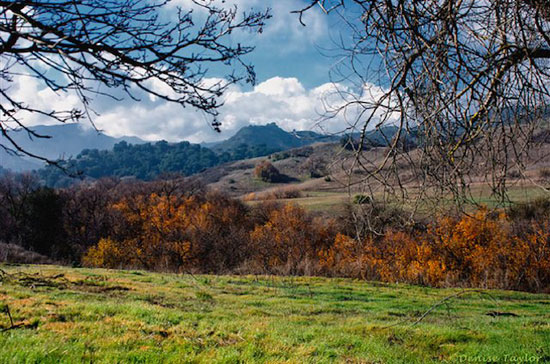
New development rules will keep the Santa Monica Mountains looking like this for future generations.
Culminating one of Los Angeles County’s longest-running environmental efforts, the Board of Supervisors on Tuesday gave final approval to a series of sweeping development restrictions that will preserve the Santa Monica Mountains as one of the nation’s premiere—and pristine—urban recreational treasures.
Passage of the Local Coastal Program (LCP) will protect an 80-square mile swath of environmentally sensitive land from construction that already has scarred some of the mountain region’s most scenic ridgelines and jeopardized fragile wildlife and plant habitats. The plan will preserve the flow of natural streams, outlaw certain rodent poisons and keep the night skies dark through tough outdoor lighting restrictions.
“We only have one Santa Monica Mountain range, and God isn’t making them anymore,” said Supervisor Zev Yaroslavsky, who vowed that the LCP will “protect one of the most beautiful mountain ranges in the state of California. It’s not the High Sierras, but then the High Sierras aren’t the Santa Monica Mountains, either.”
For nearly a decade, Yaroslavsky has championed the plan, alongside the county’s regional planning department and a broad coalition of organizations and individuals with a stake in the mountains.
During a public hearing Tuesday, the only opposition came from a handful of vintners, some of whom own vineyards in the Santa Monica Mountains above the Malibu coastline. They opposed a rule that, under the new plan, would ban the establishment of new vineyards because of their water consumption and the silt that can flow from them into natural streams, endangering wildlife.
Leading the vintners was Don Schmitz, who, in earlier hearings, had lobbied against the LCP’s rigorous new construction restrictions. Schmitz insisted that vineyards are as environmentally friendly as other forms of agriculture permitted under the plan and are a boon to the local economy.
The vineyards, he said, “bring hundreds of thousands of people into the Santa Monica Mountains to go on the wine tours, to go to local wine-tasting rooms, to go to restaurants featuring local wines.”
“It’s important for you to note,” Schmitz told the board, “that this is the Santa Monica Mountains National Recreation Area. It’s not Yosemite, which is a national park. It’s a recreation area.”
Yaroslavsky emphasized that the plan targets only new vineyards, not existing ones like those owned by Schmitz and the others who testified Tuesday. “Nobody is ripping out anybody’s vineyards,” he said.
“Nobody enjoys a glass of cabernet or merlot more than I do,” the supervisor went on to say. “But I have a lot of choices where to get my cabernet. I don’t have a lot of choices where I can see the Santa Monica Mountains National Recreation Area.”
The board approved the LCP by a 3-1 vote. Supervisor Michael D. Antonovich was the lone dissenter, arguing that the vineyard rules unfairly restrict property rights. Supervisor Mark Ridley-Thomas was absent for the vote.
The plan now faces only a final sign-off by the Coastal Coastal Commission, which gave it unanimous approvals in April and July after requesting several minor modifications. The restrictions are expected to go into effect this fall.
Posted 8/27/14
Seeking safe passage
August 13, 2014
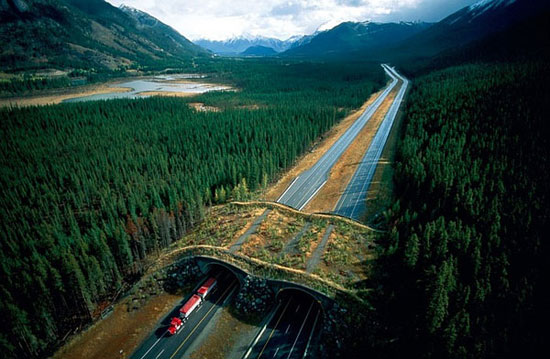
An overpass in British Columbia offers habitat linkage like that being sought here. Photo/Joel Sartore
For those on the front lines of preserving the vibrancy of wildlife in the Santa Monica Mountains, establishing a safe way for animals to get across the fast-moving 101 Freeway has been a long-held dream.
Some new developments may be pushing that vision closer to reality.
Galvanized by a series of mountain lion deaths in recent years, a multi-jurisdictional team is developing long-term strategies—including possible creation of the state’s first wildlife freeway overpass—as well as more immediate fixes to help link animals with their natural territories on either side of the 101.
Caltrans announced it has applied for a $2 million federal grant to fund environmental review and engineering design of a proposed “Liberty Canyon Wildlife Crossing” in Agoura Hills.
“US Highway 101 is an impassible barrier for wildlife migrating into or out of the Santa Monica Mountains. Animals with large home ranges, such as mountain lions, are essentially trapped within the mountain range, which can result in inbreeding and high mortality rates,” Caltrans said in announcing its grant application. “This wildlife crossing promises to provide for an improved habitat connection across a fragmented landscape, which will help sustain and improve the genetic diversity of mountain lions, deer, coyotes and other native species.”
The agency has previously applied unsuccessfully for federal funds to build a wildlife tunnel under the freeway. This time around, though, it’s seeking funding to study a range of alternatives, including the overpass. The cost and timetable of building such a structure have yet to be determined.
A decision on Caltrans’ grant application is expected before the end of the year. In the meantime, efforts are underway to jumpstart strategies that would make the crossing safer for animals even before an overpass is developed. They include:
- New and improved fencing to route animals away from the freeway and toward the existing underpass, Liberty Canyon Road.
- New vegetation around the existing underpass to also help lure animals away from the freeway and toward safety.
- Exploration of ways to enhance the wildlife-friendliness of the area, including eliminating lighting or placing it on timers.
- A commitment by the Resource Conservation District of the Santa Monica Mountains to provide architectural and landscape design services to help support the search for grant funding of the proposed new overpass.
“The idea is to have a robust crossing area,” said Clark Stevens, an architect who also serves as executive officer of the conservation district, which is working on the initiative with Caltrans, the Mountains Recreation & Conservation Authority and the office of state Senator Fran Pavley.
The stakes are high, both in the short term and over the long haul.
“What we’re interested in is making sure we continue to have a full complement of species in the Santa Monica Mountains, and that it doesn’t become an island of extinction,” Stevens said.
The overpass idea has been successfully implemented in other states, including Montana and Arizona, as well as in Canada, he said.
The proposed Liberty Canyon overpass, still in the preliminary planning stages, would be, in effect, “a piece of habitat over the freeway,” Stevens said. It could include a “guzzler” watering station for animals as well as chaparral and mature trees.
And, while animals would tend to use the crossing after-hours, humans could enjoy hiking over it during the day.
“One of the great things about it is it would allow a trail connection over the freeway that doesn’t exist anywhere else in that area,” Stevens said.
Many kinds of animals would be expected to use an overpass. But the survival and well-being of mountain lions—the Santa Monica Mountains’ “apex predator”—is particularly critical to the health of the overall ecosystem.
“Mountain lions are one of the ones that are most in need, and most in long-term danger because they exist at such low density and move over such long distances,” said Seth Riley, wildlife ecologist for the National Park Service’s Santa Monica Mountains Recreation Area. (Although mountain lions are rare in the Santa Monicas, he noted, they are common elsewhere in California and the U.S.)
Riley said scientists in the Santa Monicas currently are monitoring four adult mountain lions and two kittens via GPS-equipped collars. Another one-time resident, the male lion known as P-22, is believed to have traveled from the Santa Monicas across two freeways and into Griffith Park, where he is now at a “dead end” as far as breeding opportunities, Riley said.
By surviving that journey, P-22 is one of the lucky ones.
The current wildlife crossing efforts were galvanized by the death last October of another male mountain lion, who is believed to have made it across the 101 at Liberty Canyon, only to be forced back onto the freeway and killed after he encountered a fence he could not scale. Earlier this year, three mountain lion kittens also were killed on L.A. County roadways.
Other notable casualties include a young male lion who was shot and killed by police officers after he found his way into a courtyard in Santa Monica in 2012, and another, known as P-18, who was struck and killed by a car on the 405 Freeway near the Getty Center in 2011.
In some ways, it’s remarkable that the species has been able to survive at all in L.A.’s urban sprawl, Riley said.
“It’s an amazing thing that a large carnivore persists in Los Angeles,” he said. “If that were to be lost, that would just be a huge spiritual and aesthetic loss, I think.”

New measures aim to make life safer for even the littlest mountain lions. Photo/National Park Service
Posted 7/31/14
Shark bite opens debate
July 10, 2014
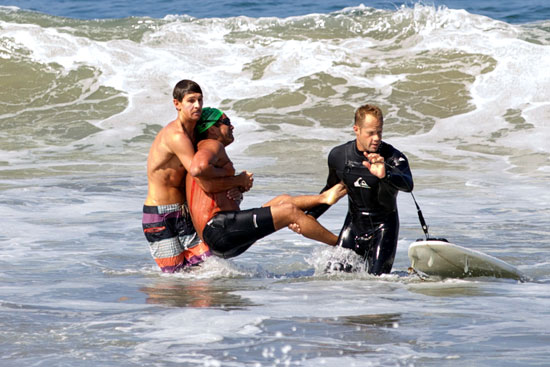
Steve Robles is pulled from the Manhattan Beach surf after his encounter with a snagged white shark.
The fisherman is off the hook. But his headline-grabbing behavior on the Manhattan Beach pier—when he snagged a young great white shark that thrashed and ended up biting a swimmer—is still churning up debate over how best to protect the beach-going public.
Manhattan Beach has quickly moved to ban all fishing from the pier for up to 60 days, although the California Department of Fish and Wildlife is weighing whether the city may have overstepped its authority on the state-owned pier. Meanwhile, Los Angeles County lifeguard officials have begun refining a new policy to create buffer zones between swimmers, surfers and the young sharks that increasingly are making Manhattan Beach their home before they head to deeper waters.
What’s more, officials now are being forced to confront an undercurrent of hostility that for years has strained relationships around the 94-year-old concrete pier, the oldest in California.
The sensational incident during the July 4th weekend—mistakenly characterized in early news reports as a shark attack—has exposed long-running complaints by surfers and swimmers that some pier fishermen have been endangering them. Among other things, they accuse fishermen of illegally “chumming”—dumping buckets of fish guts off the pier—to attract sharks.
“Tempers have been flaring,” said Los Angeles County Lifeguard Captain Kyle Daniels, who’s stationed in Manhattan Beach. “We do our best to separate the groups but it’s a dynamic situation. This goes back years.”
The Saturday incident brought it all to the surface, generating a wave of national news coverage and social media finger-pointing—most of it aimed at the fisherman and his friends, who were bombarded with allegations of animal cruelty and human indifference. The group was caught on video laughing and joking in the moments before they realized that a swimmer had been hurt by the distressed shark on the end of their high-gauge line. As of Thursday, the video had more than 1.4 million views.
According to witnesses, fisherman Jason Hagermann had been battling with the 7-footer for 45 minutes. The fish surfaced just as a group of distance swimmers passed while training for an upcoming pier-to-pier event. The victim, Steve Robles, can be heard on the video wailing as other swimmers rush to his rescue. Robles, a former L.A. County lifeguard himself, suffered serious but non-lethal gashes under his arm and along his side.
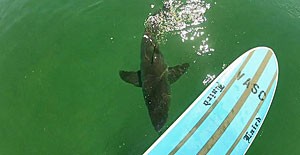
Juvenile great whites have been feeding in Manhattan Beach "like infants at an all-you-can-eat buffet."
Under state and federal law, it’s illegal to target great whites. If one gets hooked, then the line must be promptly cut. Hagermann told Fish and Wildlife investigators that he hadn’t been fishing for great whites and that he was afraid to cut the line while so many swimmers were nearby. With no evidence to contradict him, an agency spokeswoman said, no charges were filed.
Still, county lifeguard Daniels and others familiar with shark behavior insist the fish would never have bitten anyone had it not been fighting for its life. “If you lassoed and dragged a bear through a crowd,” he said, “I’m sure someone would get hurt.”
Daniels also said that the exceptionally strong wire-like line the fisherman was using posed a far greater danger to public safety than the juvenile shark. Had the fish quickly darted across and underneath the group of swimmers, “the line would have cut through to the bone.”
Laurie Jester, acting director of community development for Manhattan Beach, said the 60-day ban on pier fishing will give officials an opportunity to determine whether new restrictions should be imposed to avert these kinds of preventable risks.
“There’s a public safety concern with fishing on the pier,” she said, “and we want to make sure we’re covering all our bases, consulting with all the right people.”
The Los Angeles County Fire Department, which oversees lifeguard operations, has also moved in recent weeks to protect swimmers and surfers from potential harm.
Chief Daryl Osby said the department introduced a policy this summer to create “exclusionary zones” 300 yards into the water when sharks bigger than 8 feet are spotted because, unlike juveniles, these animals “can sometimes exhibit aggressive behavior, representing a public threat.” Osby said the department, in consultation with scientists at the Monterey Bay Aquarium, has developed a public education program “so beachgoers can become aware of the environment and habitat they’re about to enter.”
That habitat, scientists and others say, is increasingly a shared one, as rising numbers of young white sharks are taking up temporary residence at the popular El Porto surfing area, at Manhattan Beach’s northern end.
As a result, “the curious and the YouTube seekers” are boarding all sorts of crafts for a view of the sharks as they feast on the bay’s plentiful offerings, “like infants at an all-you-can-eat buffet,” said Manhattan Beach’s ex-mayor, Steve Napolitano, now a senior aide to Los Angeles County Supervisor Don Knabe, whose district includes the South Bay.
International big-wave rider Alex Gray, who’s also an avid fisherman, has been playing in the Manhattan Beach surf since he was a kid. He resents the human intrusions into the young white sharks’ habitat.
“Give the animals the respect they deserve and allow them to be at home,” he said the other day, as he looked out across the Pacific. “What if I walked into your house, took a picture of your family eating dinner and then walked out? Give respect, get respect. Just let them be.”
“I’ve traveled the world and I’ve never once had a bad encounter with a shark,” he added. “If I see a shark, I give it its area. I would never paddle up to it for a picture.”
Gray, 28, said the one thing that “breaks my heart” about the Manhattan Beach incident is that “kids might now be afraid to go into the ocean…I love this community more than anything. It hurts me when I see negativity that doesn’t need to be there.”
Posted 7/10/14
The (new) end of the trail
May 30, 2014
For years, hikers have been banned from Malibu’s Puerco Canyon Trail and the rest of a stunningly scenic 703-acre property in the Santa Monica Mountains, mostly owned by film director James Cameron.
According to Paul Edelman, chief of natural resources and planning for the Santa Monica Mountains Conservancy, visitors were met with barbed wire and security teams until a few years ago, when they were finally allowed to walk through the oak-studded property, home to a variety of wildlife.
Still, access has stopped short of the end of the trail. At one point along the way, hikers are met with a chain link fence that keeps them from connecting to the adjacent Corral Canyon Trail. And hikers on that popular 2.5-mile loop have been stymied by that same fence, which prevents them from heading into Puerco Canyon.
But that final barrier is about to fall: On Tuesday, the Los Angeles County Board of Supervisors approved a $6 million allocation to help purchase Cameron’s acreage. Also contributing to the purchase: $4.5 million from the Wildlife Conservation Board and $1.5 million from the California State Coastal Conservancy.
The new owner, the Mountains Recreation and Conservation Authority, will oversee the property with the goal of preserving open space, habitat and resources. Once escrow closes, a date for public access will be set.
The collective 24 parcels of land known as the Puerco Canyon Properties, formerly slated for housing development, represents a major piece of the geographic puzzle in Supervisor Zev Yaroslavsky’s longstanding effort to foster preservation and public access in the Santa Monica Mountains.
The property will dramatically increase access between 1000-acre Corral Canyon Park and the 7,000-plus-acre Malibu Creek State Park, Edelman said.
“It’s the last big piece in the Malibu State Park core habitat areas,” Edelman continued. “There aren’t too many big ownerships left in the Santa Monica Mountains. This is the last big sucker in L.A. County.” (The remaining large private properties in Ventura County are the 1000-acre Deer Creek Canyon property owned by the Mansdorf Family Trust and the even larger Broome Ranch).
The “last big sucker” is significant for more than its size. Contained within its borders are major sections of the new Coastal Slope Trail. This project-in-development includes a small portion of the existing Puerco Canyon Trail and will eventually run about 65 miles from Point Mugu State Park on the coast to Topanga State Park in Topanga Canyon.
Not only does the parcel facilitate new trails—its acquisition serves to preserve a delicate ecosystem. According to the coastal conservancy’s project summary for the purchase, the Santa Monica Mountains “encompass a rare biome that can be found in only four other locations on the planet.”
Vegetation and wildlife include native grassland, chaparral, coastal sage scrub, sycamore-willow woodland, oak trees and a wealth of animals, including mountain lions, bobcats, and gray foxes.
Said Edelman: “You could say that it probably has one of everything, animal-wise, with the exception of maybe salamanders. My guess would be 15 of the 19 snakes in the Santa Monica Mountains are down there, just because it’s so big.” The acquisition will also protect drainage areas that play an important role in the movement of wildlife in the area.
Not bad for a former pig farm. Along with its small enclave of luxury houses, Puerco Canyon was once home to a sprawling pig farm that existed into the 1980s.
That’s good for hikers too, Edelman said. “There’s a portion that has not been accessible to the public that has a whole system of neat little trails that were carved for the pig farm,” he said. While the trails were created for farm vehicles, they’re trail-ready for hikers and their dogs — or any pet pig that might choose to tag along.
Posted 5/30/14
County fish story no whopper
May 22, 2014
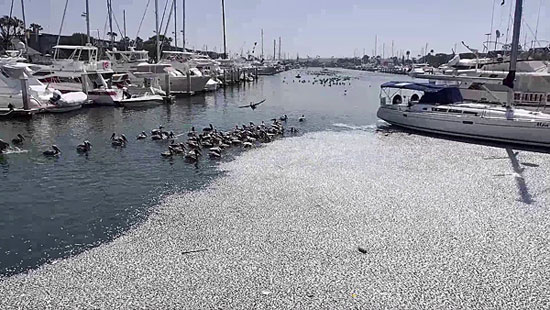
L.A. County crews hauled tons of anchovies and sardines out of the marina, with help from the pelicans.
You could see in the sky that something was fishy.
On Sunday, hundreds of pelicans were dive-bombing the waters of Marina del Rey, while swarms of screaming gulls circled overhead. “It was like a scene out of Hitchcock,” recalled Kenneth Foreman of the Los Angeles County Department of Beaches and Harbors.
But unlike the film version, these frenzied birds (and legions of gluttonous sea lions) were gorging themselves on a spread of anchovies and sardines—a very big, stinky spread. For reasons still unclear, the tiny fish had found their way into a corner of the marina, where they depleted the oxygen and suffocated.
As division chief of the agency’s facilities and property maintenance section, it was Foreman’s job to get rid of the silvery mess that had boaters and residents crying foul.
By late Sunday afternoon, less than a day after the fish surfaced en masse, Foreman’s crews had removed an estimated 6 tons of them. “Our guys did a great job in a short period of time,” said Foreman, a 30-year veteran of the department. For the record, he said, the fish carcasses weren’t placed in a shallow, sandy grave. They were transported by a disposal company to Victorville, where they’ll be converted into compost “so that some beneficial use can come of this.”
The media frenzy that surrounded the weekend die-off and clean-up offered a rare moment in the sun for Foreman’s operation. Away from the glare, his crew tackles everything from cleaning the county’s 51 beach bathrooms to stringing nets on 292 volleyball courts to alerting authorities to the occasional pre-dawn discovery of dead bodies on the sand—some of them apparent suicides.
“I guess the beach was the last thing they wanted to see,” said Foreman, whose 157 employees are also responsible for 1,169 trees, 8.5 miles of sand berms, 4,700 boat slips and 8,161 beach parking stalls.
Every year, between 50 to 60 million visitors flock to the 61 miles of beaches maintained and operated by Los Angeles County. That’s more than all the national parks combined, according to Foreman’s boss at Beaches and Harbors, Deputy Director John Kelly. He said the maintenance division, which has collected 84,000 tons of trash during the past two decades, prides itself on getting the beaches and their restrooms ready before daybreak, unlike some other jurisdictions.
In the early morning, he said, “Santa Monica [beach] parking lots are strewn with trash. You pass by the county beaches, they’re already clean.”
But Foreman’s crews also tackle many less predictable duties that don’t get public notice or end up on the division’s stat sheet.
Foreman said, for example, that in recent years the department increasingly has been called on to help law enforcement authorities deal with “panga” boats abandoned on the sand by drug dealers or illegal immigrants trying to come ashore. The last incident, he said, occurred near Manhattan Beach and led to the arrest of 20 people allegedly trying to enter the country illegally.
More often, however, the department is dispatched to get rid of old, unseaworthy boats that have broken free of makeshift moorings and ended up shipwrecked on the sand.
Sometimes, the division confronts ocean creatures very different from those tiny specimens it encountered over the weekend. It’s not unusual, Foreman said, for dead sea lions, dolphins or whales to wash up on the county’s beaches, as two did in 2012. “Ideally,” he said, “we try to tow them out to sea so Mother Nature can take care of them.” But if it looks like the tide might push them back to shore, “then we try to bury them in the sand.”
“In this department,” he added, “we’ve seen it all. There’s never an opportunity to get bored. Something new and different is going to occur, guaranteed.”
Posted 5/22/14
New beach chief rides the waves
May 8, 2014
Gary Jones’ new job as director of the Los Angeles Department of Beaches and Harbors is a little like going surfing while wearing a tie. It’s an ongoing attempt to marry L.A.’s freewheeling beach culture with business concerns such as permits, parking, environmental impact and—always—budget.
Access to L.A. County’s beaches remains an emotional issue for residents, many of whom treasure days at a local beach among childhood memories, Jones says. The 45-year-old Englishman’s first visit to Southern California took him to Venice’s Muscle Beach. “Venice Beach and the L.A. lifeguards are iconic, in part from Baywatch. Surfing, the beach life, the fire pits —that type of culture is very much transmitted around the world,” Jones says.
Jones’ Marina del Rey office affords a picture-postcard view of blue sky, seagulls and sailboats. Hailing from the English “rowing town” of Bedford, he loves to observe rowing teams from UCLA and Loyola Marymount University take on the chilly early mornings. On his desk are the less enticing realities of the gig: The first proposed increases in fees affecting the public since 2009 are set to come before the Board of Supervisors next week. They include increases in summer parking fees, beach permits for organized recreational classes such as yoga, youth camp expenses and dry storage of trailered boats.
And if past experience is any guide, those kinds of changes—ranging from new meet-up rules to a misunderstood Frisbee policy—can kick up a lot of sand.
“In the dynamics surrounding the county’s operation and ownership of beaches and the coastline, there are some very interesting forces at play,” adds Jones, who served as interim director for eight months before stepping into the permanent post on April 15. “Underpinning it all is that overwhelming sense that this is something the public should have access to. Some people think that access translates to free, or as low cost as possible. Or if I want to join 50 or 100 of my closest friends and train for a triathlon, I can do that.”
Standing out among the currently proposed increases are a new fee for the annual senior parking pass ($25) and substantial hikes for five-day youth camps, some of which have recently been on hiatus. Sailing and surf camp fees would go up sharply (sailing rising from $165 per participant to $375, surf camp from $165 to $300). Jones notes that the department continues to look for ways to cut operating costs so fees may end up being lower than proposed. He adds the department will still give financial assistance to needy participants.
Jones says the department is also looking to expand the county’s popular water taxi service that transports the public to concerts and events at Chace Park, along with other stops including Fisherman’s Village and Mother’s Beach. This summer, the service is slated to begin June 19.
Jones, who moved to the U.S. in 1998, began his Southern California career managing assets for the city of San Diego. He came to Los Angeles County’s beaches and harbors department in 2009. Jones stepped into the interim director position when then-director Santos Kreimann became acting county assessor after the elected assessor, John Noguez, was placed on leave pending a trial on corruption charges.
With the approach of Memorial Day and the traditional opening of summer beach season, Jones says his foremost concerns include the continuing redevelopment of Marina del Rey (money from private development flows into the general fund, he says) and beach maintenance for the summer onslaught (sand grooming, restroom upgrades, parking lot re-surfacing).
Also at the top of the list: A greater social media presence and a more user-friendly website to provide up-to-the-minute information on parking and rates, easily accessible by smart phone or tablet.
Jones adds that some beaches require a delicate balance between humans and wildlife. Visitors don’t always understand the needs of the grunion or the Snowy Plover, or why the “rack line” of seaweed left behind by the tide represents an important ecosystem, not just a source of odor and pesky sand flies. “We have 50 million plus people using our beaches every year —how do you balance that with being a good environmental steward?” muses Jones.
And why did Jones take on this balancing act? “No municipal department has the blend of what this department is responsible for,” Jones asserts.
“I don’t think I could have been satisfied churning out commercial real estate deals or office deals,” he says. “It’s very rewarding when you see a project come together and you see people enjoying it, the impact it has on a community. I think that’s what makes me tick.”
Posted 5/7/14
Art that keeps it clean in Malibu
April 17, 2014
Few Malibu visitors look to the city’s storm drains for inspirational scenery. But those mundane slots under the curb have a big job that’s crying out for a little artistic appreciation.
Now it’s getting some. This week, four colorful street murals will be unveiled at storm drains throughout the coastal city, designed and painted by Lindsay Carron, a local artist known for her activism in ecological causes.
The on-the-ground depictions of sea life and rain gardens are part of an ongoing campaign to remind passersby that what falls onto the streets washes into the ocean.
“We needed to communicate this message about protecting areas of environmental significance from urban runoff, and we had already tried the traditional outreach campaigns and typical marketing strategies,” says Casey Zweig, coastal preservation specialist with the city.
“So we thought public art might be something that would grab people and interrupt their regular routine.”
The message is critical along the Malibu coastline, which supports such a diversity of marine life that the state has designated it as one of 34 Areas of Special Biological Significance. The designation, conferred by the state Water Resources Control Board, carries heightened environmental restrictions, particularly on runoff.
From Latigo Point to Laguna Point near Point Mugu, nothing but pure, clean rainwater is supposed to be discharged into the ocean. That means locals have to be constantly vigilant about the ways in which inland pollution can inadvertently be washed down the storm drains and into the water—lawn chemicals that can be carried to the beach on water from a broken sprinkler, for instance. Or soapy, oily water that can flow into the drain when a car is washed curbside. Or the mountains of plastic bags and cigarette butts and foam cups that course down the drains and into the seaweed every time it rains.
The city has come at the problem from a number of angles, ranging from education and outreach to facilities designed to catch and treat runoff before it reaches the beach. Underground biofiltration systems are being built into the natural topography at Wildlife Road and Broad Beach Road to capture and cleanse urban runoff. At Pacific Coast Highway and Cross Creek Road, a vacant lot has been turned into a 15-acre park that doubles as another state-of-the-art runoff cleaning machine. Yet another city program encourages locals to convert traditional landscapes to ocean-friendly rain gardens.
Zweig says the “Keep It Clean, Malibu” public art gambit was among the last to be funded by a 2½-year state grant that the city received to pay for education and outreach, and was inspired by a similar storm drain project in Reno. With approval from the City Council, the city’s Cultural Arts Commission put out a call in February for artists to create art around storm drain inlets at Point Dume Shopping Center, Trancas Park, Cross Creek Road and the corner of Morning View Drive and Philip Avenue.
That call caught the attention of Deborah Collodel, a local art lover who immediately thought of Carron, whose work she had discovered several years ago during a spur-of-the-moment visit to the campus gallery at Carron’s alma mater, Pepperdine University.
“They were looking for a muralist and she immediately came to mind because she has done so much work that combines art with awareness,” Collodel says, adding that she and her husband collect Carron’s work, and have hung it at the Malibu Motel, their local business.
Carron’s activist art ranges from murals in Skid Row and Baja to detailed pen-and-ink renderings of wolves for the California Wolf Center. Now 24 and living in Culver City, Carron says she rushed to meet the entry deadline as soon as her friend called her.
“Mural work is a fantastic way to reach people who wouldn’t necessarily be interested in art, or involved in the art realm,” she says. “And I knew this project would give me the chance to connect with the community.”
Her winning design beat out 17 other contenders for the $3,200 commission, depicting not only what’s at stake—the well-being of Malibu’s dolphins, sharks, sea lions and other marine life—but also a potential solution: drought tolerant rain gardens full of rocks, succulents and colorful wildflowers. The seascapes cover the concrete mouths of the storm drains, while the rain gardens decorate the area above the curb.
Though the official ribbon cutting was set for this week at the project’s Trancas Park location, Carron and the city’s Zweig say they already have gotten positive feedback, not only about the murals but about their theme.
“I did a little research into urban runoff, and wanted to say, OK, what can we do to prevent this,” Carron says. “Rain gardens take in excess water from rain or car washing or dumping, and filter it through the soil, where it can be used by plants instead of draining it into a storm drain. It’s a buffer. I liked the idea because it’s not only simple, but also beautiful.”
Posted 4/17/14
Get ready for the slow lane on PCH
April 10, 2014
Pacific Coast Highway may be famed for its scenic vistas, but for locals, the real talk of the town is its construction zones.
“It’s a running joke here,” says 14-year resident P.J. Manney. “As soon as the tourists arrive, Caltrans shows up. This year, though, we’re actually a little freaked out.”
That’s because, beginning next week, traffic in Malibu and Santa Monica is expected to become extra congested for locals, commuters and sightseers, thanks to two long-term and several shorter-term public works projects along PCH.
The upshot? An already frustrating—and occasionally dangerous—stretch of one of America’s most storied highways is about to acquire even more roadblocks.
“The reasons are all positive, but getting there is going to be a real inconvenience,” sighs Elizabeth Anthony, who is bracing for a long, gridlocked summer near her home on Point Dume.
“I can’t say we shouldn’t have these projects, but for those who live out here, they’re a real concern.”
The roadwork arises from a variety of safety and environmental issues, and is being coordinated by the various jurisdictions. Among other measures to minimize the pain, officials plan to use “dynamic lanes” to ease traffic backups, creating more southbound lanes on PCH during morning rush hour, for instance, and more northbound lanes in the evening rush when commuters are heading home.
Still, locals say, PCH will be a slog. Among the projects:
- The second phase of the $9 million Coastal Interceptor Relief Sewer. This will shut down a 900-foot southbound stretch of PCH to expand sewer capacity between Chautauqua Boulevard and the Annenberg Community Beach House. Expected to start April 15, the year-long City of Los Angeles project will improve the capture of urban runoff that now runs directly into the ocean. The upgrade, financed by a bond measure, is necessary to meet federal water quality standards. Work will occur every day except on Sundays.
- A City of Santa Monica repair and repaving project around the California Incline, the slanted street that connects Ocean Avenue along the Santa Monica bluffs to PCH down below. Work will start in early September and is expected to continue at least through 2015.
- An assortment of safety-related City of Malibu projects, some of which have already begun. A particularly hazardous intersection at PCH and Big Rock Drive, for instance, will finally get a long-awaited left-turn signal, and a nearly 25-year-old “arrestor ramp” for runaway trucks is being improved at the Kanan Dume Road intersection with the coast.
Besides these big-ticket projects, “we’re also putting in a new, lit crosswalk at La Costa and doing a bike lane project from Busch Drive north to the northern city limits along PCH,” says Malibu Councilwoman Laura Zahn Rosenthal. Several bus stops also are being upgraded and traffic messaging will be improved.
Work is expected to be finished before summer, Rosenthal says, adding that the inconvenience ultimately will be worth it.
“That turning lane at Big Rock will make a big difference to the 240 homes up there,” she says. “We have bus stops right now that peoples’ legs actually hang over onto PCH if they sit on the bus bench. And we’ve been trying for a long time to make the Zuma Beach area safer.”
Cyclists say they are especially grateful for the Zuma Beach project, which will make it easier for bike traffic to get past the parked cars that often line the shoulder of the road on the beach side of the highway.
“There’s an area there that’s covered in ice plant and people park unevenly around it,” says Eric Bruins, planning and policy director of the Los Angeles County Bicycle Coalition. “So you’ll be going along and there’ll be five cars parked evenly along the shoreline and then one that’s haphazard. There are a lot of near misses that easily could become tragic if they aren’t fixed.”
In the meantime, however, Bruins says, his constituency, too, is bracing for even more PCH difficulties than usual.
“It’s already not for the faint of heart,” he says, noting that most motorists believe—incorrectly—that bicyclists are required to keep to the shoulder. Bruins says that, on PCH, that shoulder waxes and wanes, in part because of natural landslides and coastal erosion, so bicyclists frequently find themselves forced to merge with other traffic, which can be lethal.
Locals, meanwhile, say they’ll simply try to go with the slow-flow, though some predict their Westside coping skills will be challenged.
“Some of my friends are hunkering down in Malibu and will be working at home,” says Manney. “My husband’s offices are in Beverly Hills and Orange County, though.”
The family’s solution? “He’s going to start renting hotel rooms.”
Posted 4/10/14




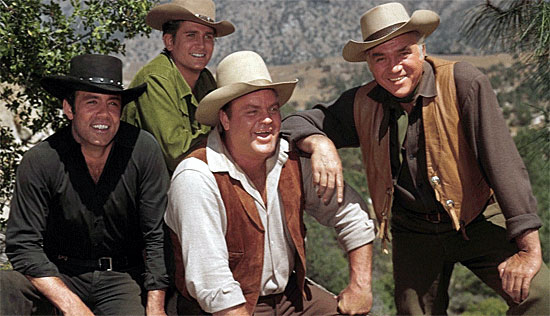

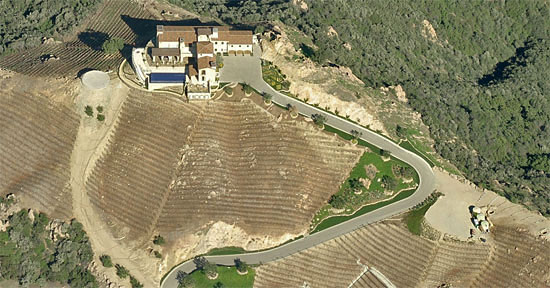
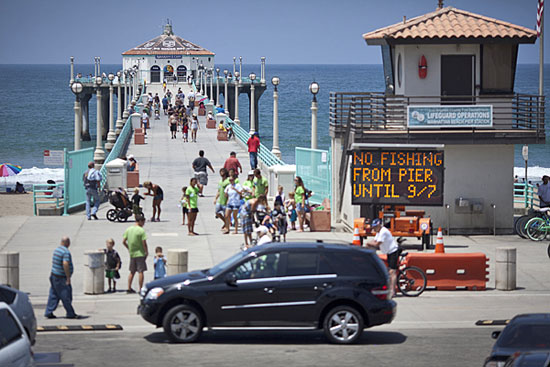


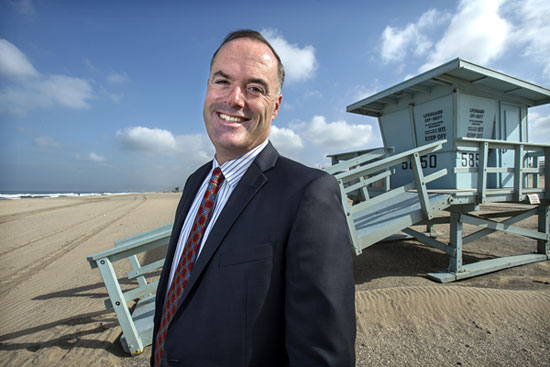
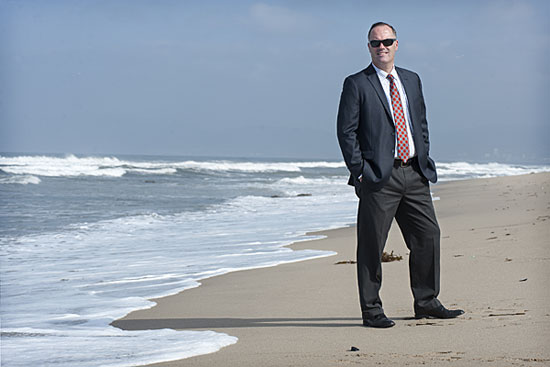



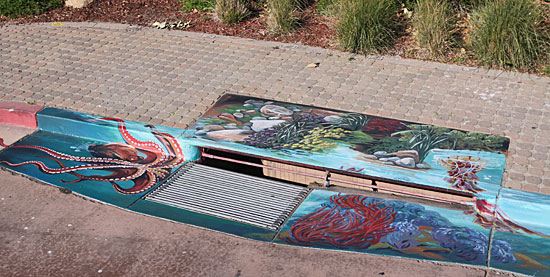
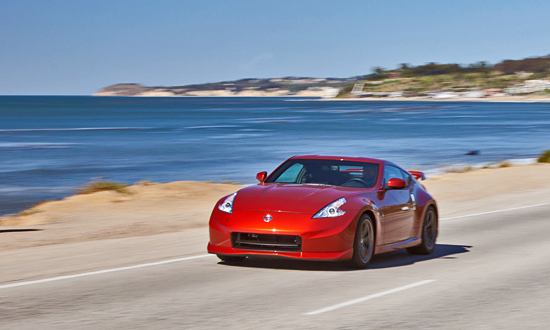







 405 bridge work causes a stink
405 bridge work causes a stink
